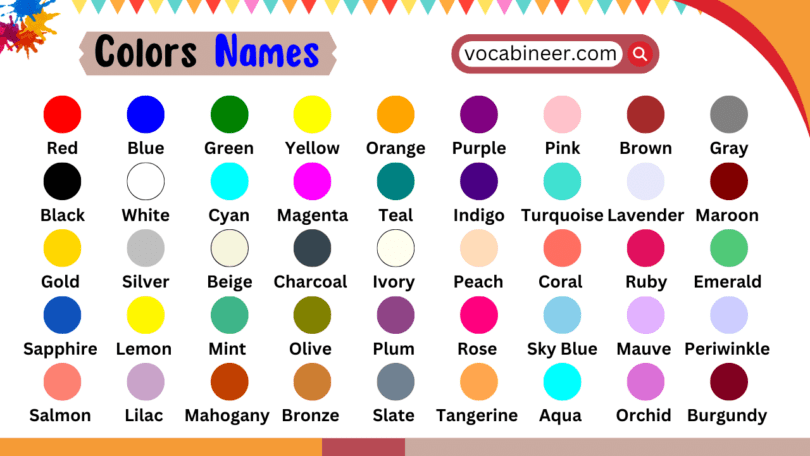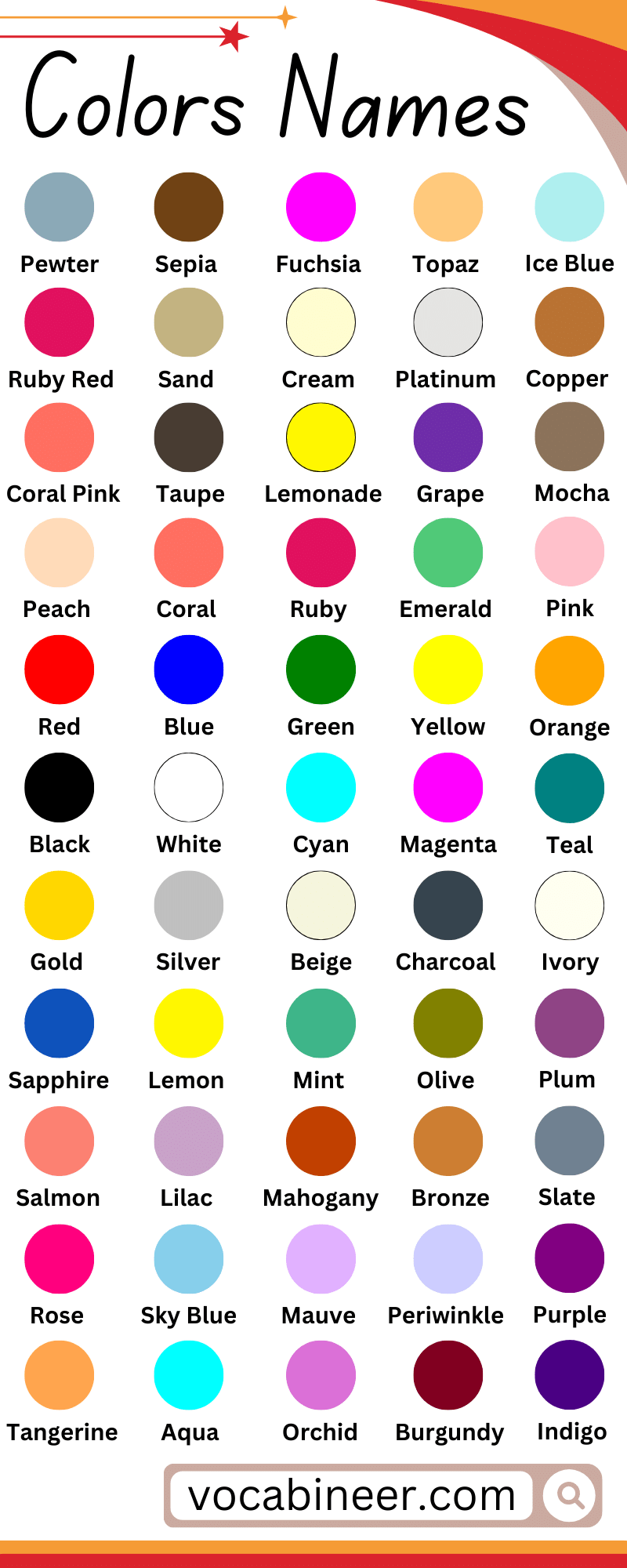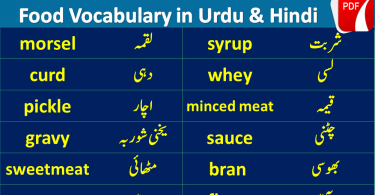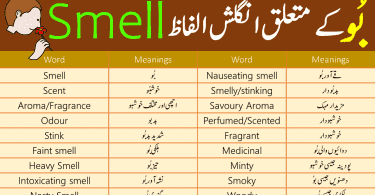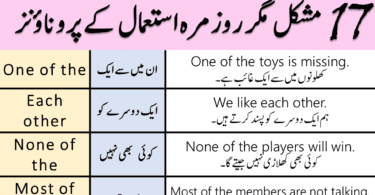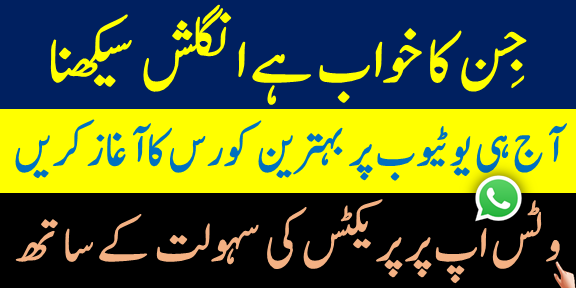Colors names are special words we use for different colors. They help us talk about colors in interesting ways. Let’s learn more about these special words.
Remember, List of 140 Colors Names aren’t just names. They are like storytellers for colors. When you want to talk about a beautiful red color, you can use “vermillion.” If something is really, really dark, like the night, you can say “obsidian.” “Saffron” is perfect for describing a sunny, golden day, and “chartreuse” adds life to your words when you talk about a vibrant, yellow-green color.
List of 140 Colors Names
| Sr No. | Color Name |
Html Color Codes
|
| 1. | Alice Blue | #F0F8FF |
| 2. | Antique White | #FAEBD7 |
| 3. | Aqua | #00FFFF |
| 4. | Aquamarine | #7FFFD4 |
| 5. | Azure | #F0FFFF |
| 6. | Beige | #F5F5DC |
| 7. | Bisque | #FFE4C4 |
| 8. | Black | #000000 |
| 9. | Blanched Almond | #FFEBCD |
| 10. | Blue | #0000FF |
| 11. | Cyan | #00FFFF |
| 12. | Dark Blue | #00008B |
| 13. | Dark Cyan | #008B8B |
| 14. | Dark Goldenrod | #B8860B |
| 15. | Dark Gray | #A9A9A9 |
| 16. | Dark Green | #006400 |
| 17. | Dark Khaki | #BDB76B |
| 18. | Dark Magenta | #8B008B |
| 19. | Dark Olive Green | #556B2F |
| 20. | Dark Orange | #FF8C00 |
| 21. | Blue Violet | #8A2BE2 |
| 22. | Brown | #A52A2A |
| 23. | Burly Wood | #DEB887 |
| 24. | Cadet Blue | #5F9EA0 |
| 25. | Chartreuse | #7FFF00 |
| 26. | Chocolate | #D2691E |
| 27. | Coral | #FF7F50 |
| 28. | Cornflower Blue | #6495ED |
| 29. | Cornsilk | #FFF8DC |
| 30. | Crimson | #DC143C |
| 31. | Dim Gray | #696969 |
| 32. | Dodger Blue | #1E90FF |
| 33. | Fire Brick | #B22222 |
| 34. | Floral White | #FFFAF0 |
| 35. | Forest Green | #228B22 |
| 36. | Fuchsia | #FF00FF |
| 37. | Gainsboro | #DCDCDC |
| 38. | Ghost White | #F8F8FF |
| 39. | Gold | #FFD700 |
| 40. | Goldenrod | #DAA520 |
| 41. | Dark Orchid | #9932CC |
| 42. | Dark Red | #8B0000 |
| 43. | Dark Salmon | #E9967A |
| 44. | Dark Sea Green | #8FBC8B |
| 45. | Dark Slate Blue | #483D8B |
| 46. | Dark Slate Gray | #2F4F4F |
| 47. | Dark Turquoise | #00CED1 |
| 48. | Dark Violet | #9400D3 |
| 49. | Deep Pink | #FF1493 |
| 50. | Deep Sky Blue | #00BFFF |
| 51. | Gray | #808080 |
| 52. | Green | #008000 |
| 53. | Green Yellow | #ADFF2F |
| 54. | Honey Dew | #F0FFF0 |
| 55. | Hot Pink | #FF69B4 |
| 56. | Indian Red | #CD5C5C |
| 57. | Indigo | #4B0082 |
| 58. | Ivory | #FFFFF0 |
| 59. | Khaki | #F0E68C |
| 60. | Lavender | #E6E6FA |
| 61. | Light Salmon | #FFA07A |
| 62. | Light Salmon | #FFA07A |
| 63. | Light Sea Green | #20B2AA |
| 64. | Light Sky Blue | #87CEFA |
| 65. | Light Slate Gray | #778899 |
| 66. | Light Steel Blue | #B0C4DE |
| 67. | Light Yellow | #FFFFE0 |
| 68. | Lime | #00FF00 |
| 69. | Lime Green | #32CD32 |
| 70. | Linen | #FAF0E6 |
| 71. | Medium Spring Green | #00FA9A |
| 72. | Lavender Blush | #FFF0F5 |
| 73. | Lawn Green | #7CFC00 |
| 74. | Lemon Chiffon | #FFFACD |
| 75. | Light Blue | #ADD8E6 |
| 76. | Light Coral | #F08080 |
| 77. | Light Cyan | #E0FFFF |
| 78. | Light Goldenrod Yellow | #FAFAD2 |
| 79. | Light Gray | #D3D3D3 |
| 80. | Light Green | #90EE90 |
| 81. | Light Pink | #FFB6C1 |
| 82. | Magenta | #FF00FF |
| 83. | Maroon | #800000 |
| 84. | Medium Aquamarine | #66CDAA |
| 85. | Medium Blue | #0000CD |
| 86. | Medium Orchid | #BA55D3 |
| 87. | Medium Purple | #9370DB |
| 88. | Medium Sea Green | #3CB371 |
| 89. | Medium Slate Blue | #7B68EE |
| 90. | Medium Slate Blue | #7B68EE |
| 91. | Olive Drab | #6B8E23 |
| 92. | Orange | #FFA500 |
| 93. | Orange Red | #FF4500 |
| 94. | Orchid | #DA70D6 |
| 95. | Pale Goldenrod | #EEE8AA |
| 96. | Pale Green | #98FB98 |
| 97. | Pale Turquoise | #AFEEEE |
| 98. | Pale Violet Red | #DB7093 |
| 99. | Papaya Whip | #FFEFD5 |
| 100. | Peach Puff | #FFDAB9 |
| 101. | Medium Turquoise | #48D1CC |
| 102. | Medium Violet Red | #C71585 |
| 103. | Midnight Blue | #191970 |
| 104. | Mint Cream | #F5FFFA |
| 105. | Misty Rose | #FFE4E1 |
| 106. | Moccasin | #FFE4B5 |
| 107. | Navajo White | #FFDEAD |
| 108. | Navy | #000080 |
| 109. | Old Lace | #FDF5E6 |
| 110. | Olive | #808000 |
| 111. | Salmon | #FA8072 |
| 112. | Sandy Brown | #F4A460 |
| 113. | Sea Green | #2E8B57 |
| 114. | Sea Shell | #FFF5EE |
| 115. | Sienna | #A0522D |
| 116. | Silver | #C0C0C0 |
| 117. | Sky Blue | #87CEEB |
| 118. | Slate Blue | #6A5ACD |
| 119. | Slate Gray | #708090 |
| 120. | Snow | #FFFAFA |
| 121. | Peru | #CD853F |
| 122. | Pink | #FFC0CB |
| 123. | Plum | #DDA0DD |
| 124. | Powder Blue | #B0E0E6 |
| 125. | Purple | #800080 |
| 126. | Rebecca Purple | #663399 |
| 127. | Red | #FF0000 |
| 128. | Rosy Brown | #BC8F8F |
| 129. | Royal Blue | #4169E1 |
| 130. | Saddle Brown | #8B4513 |
| 131. | White Smoke | #F5F5F5 |
| 132. | Yellow | #FFFF00 |
| 133. | Yellow Green | #9ACD32 |
| 134. | Spring Green | #00FF7F |
| 135. | Steel Blue | #4682B4 |
| 136. | Tan | #D2B48C |
| 137. | Teal | #008080 |
| 138. | Thistle | #D8BFD8 |
| 139. | Tomato | #FF6347 |
| 140. | Turquoise | #40E0D0 |
| 141. | Violet | #EE82EE |
| 142. | Wheat | #F5DEB3 |
| 143. | White | #FFFFFF |
List of 140 Colors Names with Descriptions
Alice Blue: Alice Blue is a very light and peaceful shade of blue, like a calm and clear sky. It’s named after Alice Roosevelt Longworth and is known for its soft and gentle appearance.
Antique White: Antique White is a creamy and slightly off-white color, resembling the aged and elegant appearance of antique furniture. It’s a warm and timeless shade often used in interior design for a classic and refined look.
Aqua: Aqua is a happy mix of blue and green, like the color of a clean swimming pool. It feels fresh and calm.
Aquamarine: Aquamarine is a calm and soothing color, like the beautiful blue-green sea on a sunny day at the beach.
Azure: Azure is a bright and cheerful blue, similar to the sky on a sunny day. It’s a happy and vibrant color that brings a sense of openness and positivity.
Beige: Beige is a neutral and gentle color, like a soft sandy beach. It’s simple and goes well with many other colors, making it a popular choice for a cozy and warm feel in decor.
Bisque: Bisque is a warm and pale shade, similar to the color of a toasted almond. It adds a cozy and inviting touch to spaces.
Black: Black is the darkest color, like the night sky. It represents mystery and elegance and goes well with many other colors.
Blanched Almond: Blanched Almond is a soft and muted beige with a hint of warmth. It’s a soothing and versatile color choice.
Blue: Blue is a calming color, similar to the color of the sky on a clear day. It represents tranquility and is a favorite for many.
Cyan: Cyan is a bright and refreshing blue-green color, like a tropical sea. It evokes a sense of relaxation and clarity.
Dark Blue: Dark Blue is a deep and rich shade of blue, like the midnight sky. It carries a sense of depth and stability.
Dark Cyan: Dark Cyan is a deeper version of cyan, resembling the color of deep ocean waters. It’s tranquil and serene.
Dark Goldenrod: Dark Goldenrod is a warm and muted yellow-brown color. It adds a touch of coziness and richness to decor.
Dark Gray: Dark Gray is a deep and neutral shade, suitable for creating a sophisticated and timeless look.
Dark Green: Dark Green is a rich and earthy color, like the color of lush forests. It conveys a sense of growth and balance.
Dark Khaki: Dark Khaki is a subdued, earthy color, reminiscent of khaki pants. It exudes a sense of ruggedness and simplicity.
Dark Magenta: Dark Magenta is a deep and intense shade of purple-pink. It’s vibrant and passionate, making a bold statement.
Dark Olive Green: Dark Olive Green is a rich green-brown color, like the color of olive tree leaves. It symbolizes growth and stability.
Dark Orange: Dark Orange is a deep and warm shade, resembling a ripe orange. It’s energetic and invokes feelings of enthusiasm.
Blue Violet: Blue Violet is a beautiful blend of blue and purple, like the petals of some flowers. It’s a harmonious and creative color.
Brown: Brown is a natural and earthy color, like tree bark. It signifies reliability and comfort, often used in rustic design.
Burly Wood: Burly Wood is a warm and light brown shade, akin to the color of weathered wood. It brings a sense of warmth and character to decor.
Cadet Blue: Cadet Blue is a soft and muted blue-gray color, reminiscent of military uniforms. It conveys a subtle and timeless elegance.
Chartreuse: Chartreuse is a lively and bright yellow-green color, similar to some plants. It represents energy and vibrancy.
Chocolate: Chocolate is a rich and indulgent brown, like the color of dark chocolate. It’s associated with comfort and indulgence.
Coral: Coral is a vibrant reddish-orange color, like the beautiful coral reefs. It symbolizes enthusiasm and creativity.
Cornflower Blue: Cornflower Blue is a soft and calming shade of blue, resembling the color of cornflower petals. It evokes a sense of tranquility.
Cornsilk: Cornsilk is a pale and warm shade, similar to the color of cornsilk. It radiates comfort and simplicity.
Crimson: Crimson is a bold and intense shade of red, like a deep red rose. It represents passion and strength.
Dim Gray: Dim Gray is a muted and neutral gray color, offering a subtle and understated aesthetic.
Dodger Blue: Dodger Blue is a bright and lively shade of blue, reminiscent of the color of the Los Angeles Dodgers. It conveys a sense of excitement and energy.
Fire Brick: Fire Brick is a deep and rich shade of red-brown, resembling the color of fired clay bricks. It symbolizes durability and warmth.
Floral White: Floral White is a pure and creamy white color, like the petals of white flowers. It exudes simplicity and elegance.
Forest Green: Forest Green is a deep and lush green color, like the color of dense forests. It signifies growth and tranquility.
Fuchsia: Fuchsia is a vibrant and intense pink-purple color, like the blossoms of the fuchsia plant. It embodies creativity and playfulness.
Gainsboro: Gainsboro is a light and silvery gray color, offering a gentle and sophisticated appearance.
Ghost White: Ghost White is an ethereal and nearly-white shade, resembling a ghostly, pale mist. It creates an airy and delicate ambiance.
Gold: Gold is a precious and luxurious metallic color, symbolizing wealth, opulence, and grandeur.
Goldenrod: Goldenrod is a warm and vibrant yellow color, similar to the blossoms of the goldenrod plant. It radiates energy and cheerfulness.
Dark Orchid: Dark Orchid is a deep and intense shade of purple, like the color of orchid blooms. It represents creativity and sophistication.
Dark Red: Dark Red is a rich and velvety shade of red, signifying passion and strength.
Dark Salmon: Dark Salmon is a muted and dusky pink-orange color, reminiscent of salmon fish. It conveys a sense of warmth and comfort.
Dark Sea Green: Dark Sea Green is a deep and tranquil shade of green, resembling the color of seawater. It signifies harmony and serenity.
Dark Slate Blue: Dark Slate Blue is a deep and moody shade of blue, akin to the color of slate rock. It exudes depth and mystery.
Dark Slate Gray: Dark Slate Gray is a muted and neutral gray color, offering a subtle and timeless aesthetic.
Dark Turquoise: Dark Turquoise is a rich and vibrant blue-green color, like the depths of the ocean. It symbolizes depth and creativity.
Dark Violet: Dark Violet is a deep and intense shade of purple, signifying creativity, luxury, and mystery.
Deep Pink: Deep Pink is a bold and intense shade of pink, radiating passion and energy.
Deep Sky Blue: Deep Sky Blue is a bright and vivid shade of blue, resembling the color of a clear daytime sky. It symbolizes optimism and clarity.
Gray: Gray is a neutral and versatile color, often associated with practicality and balance.
Green: Green is the color of nature and growth, signifying harmony and renewal.
Green Yellow: Green Yellow is a cheerful and bright yellow-green color, combining the energy of green and the warmth of yellow.
Honey Dew: Honey Dew is a soft and pale green color, similar to the color of ripe honeydew melons. It brings a sense of freshness and simplicity.
Hot Pink: Hot Pink is a vibrant and bold shade of pink, symbolizing excitement and playfulness.
Indian Red: Indian Red is a warm and earthy shade of red-brown, often associated with traditional Indian pigments. It signifies cultural richness and warmth.
Indigo: Indigo is a deep and mystical shade of blue-purple, reminiscent of the color of indigo dye. It represents depth and spirituality.
Ivory: Ivory is a soft and creamy off-white color, often associated with elegance and simplicity.
Khaki: Khaki is a muted and earthy brownish-green color, resembling the color of khaki pants. It conveys a sense of practicality and reliability.
Lavender: Lavender is a soft and soothing shade of purple, like the color of lavender flowers. It symbolizes calmness and relaxation.
Light Salmon: Light Salmon is a gentle and peachy-pink color, resembling the flesh of a salmon. It conveys warmth and comfort.
Light Sea Green: Light Sea Green is a soft and refreshing blue-green color, reminiscent of tranquil sea waters. It signifies tranquility and rejuvenation.
Light Sky Blue: Light Sky Blue is a delicate and clear shade of blue, resembling the color of a clear sky during the day. It represents serenity and openness.
Light Slate Gray: Light Slate Gray is a muted and neutral gray color with a touch of softness. It offers a subtle and sophisticated appearance.
Light Steel Blue: Light Steel Blue is a muted and cool blue-gray color, symbolizing calmness and stability.
Light Yellow: Light Yellow is a gentle and pale shade of yellow, like the color of soft sunlight. It radiates positivity and optimism.
Lime: Lime is a lively and vibrant green color, reminiscent of the color of fresh limes. It embodies energy and freshness.
Lime Green: Lime Green is a bright and zesty shade of green, combining the vibrancy of lime and the freshness of green. It signifies liveliness and creativity.
Linen: Linen is a natural and muted off-white color, resembling the color of linen fabric. It exudes simplicity and comfort.
Medium Spring Green: Medium Spring Green is a lively and refreshing shade of green, reminiscent of the vibrant colors of springtime.
Lavender Blush: Lavender Blush is a gentle and delicate shade of lavender-pink, like the color of blushing lavender petals. It represents softness and tenderness.
Lawn Green: Lawn Green is a bright and vibrant green color, akin to the lush green of well-maintained lawns. It signifies growth and vitality.
Lemon Chiffon: Lemon Chiffon is a soft and pale yellow color, like the color of lemon chiffon pie. It brings a sense of lightness and sweetness.
Light Blue: Light Blue is a soft and calming shade of blue, symbolizing tranquility and clarity.
Light Coral: Light Coral is a warm and muted shade of coral-pink, representing comfort and subtlety.
Light Cyan: Light Cyan is a pale and soothing blue-green color, evoking feelings of serenity and relaxation.
Light Goldenrod Yellow: Light Goldenrod Yellow is a gentle and warm yellow color, resembling the color of goldenrod flowers. It radiates positivity and cheerfulness.
Light Gray: Light Gray is a soft and neutral gray color, offering a sense of balance and simplicity.
Light Green: Light Green is a mild and pleasant shade of green, signifying renewal and harmony.
Light Pink: Light Pink is a soft and gentle shade of pink, like the color of delicate flower petals. It represents sweetness and compassion.
Magenta: Magenta is a bold and vibrant shade of purple-pink, symbolizing creativity and confidence.
Maroon: Maroon is a deep and rich shade of red-brown, reminiscent of the color of maroon wine. It signifies sophistication and depth.
Medium Aquamarine: Medium Aquamarine is a calming and aquatic shade of blue-green, resembling the color of clear ocean waters. It represents tranquility and clarity.
Medium Blue: Medium Blue is a balanced and timeless shade of blue, symbolizing stability and reliability.
Medium Orchid: Medium Orchid is a soft and harmonious shade of purple, resembling the color of orchid blooms. It represents creativity and elegance.
Medium Purple: Medium Purple is a versatile and balanced shade of purple, signifying imagination and balance.
Medium Sea Green: Medium Sea Green is a soothing and balanced blue-green color, reminiscent of serene sea vistas. It symbolizes harmony and rejuvenation.
Medium Slate Blue: Medium Slate Blue is a calm and muted shade of blue, evoking feelings of serenity and stability.
Olive Drab: Olive Drab is a muted and earthy green-brown color, resembling the color of military uniforms. It signifies practicality and durability.
Orange: Orange is a bright and energetic color, symbolizing enthusiasm and vitality.
Orange Red: Orange Red is a fiery and intense shade of red-orange, representing passion and warmth.
Orchid: Orchid is a soft and graceful shade of purple-pink, reminiscent of the elegant orchid flowers. It signifies beauty and refinement.
Pale Goldenrod: Pale Goldenrod is a gentle and muted yellow color, like the color of pale goldenrod flowers. It represents warmth and subtlety.
Pale Green: Pale Green is a soft and refreshing shade of green, symbolizing renewal and tranquility.
Pale Turquoise: Pale Turquoise is a delicate and calming blue-green color, evoking feelings of serenity and relaxation.
Pale Violet Red: Pale Violet Red is a muted and gentle shade of violet-pink, representing softness and tenderness.
Papaya Whip: Papaya Whip is a creamy and pale orange color, like the color of papaya fruit. It brings a sense of sweetness and lightness.
Peach Puff: Peach Puff is a warm and gentle shade of peach, symbolizing comfort and softness.
Medium Turquoise: Medium Turquoise is a vibrant and refreshing blue-green color, reminiscent of the color of turquoise gemstones. It signifies energy and positivity.
Medium Violet Red: Medium Violet Red is a bold and passionate shade of violet-red, representing creativity and intensity.
Midnight Blue: Midnight Blue is a deep and dark shade of blue, like the color of the night sky. It embodies depth and mystery.
Mint Cream: Mint Cream is a soft and cool shade of pale green, symbolizing freshness and lightness.
Misty Rose: Misty Rose is a delicate and muted shade of pink, resembling the color of rose petals. It signifies gentleness and grace.
Moccasin: Moccasin is a warm and earthy shade of pale brown, reminiscent of the color of moccasin shoes. It represents comfort and simplicity.
Navajo White: Navajo White is a creamy and off-white color, symbolizing warmth and purity.
Navy: Navy is a classic and deep shade of blue, often associated with sophistication and elegance.
Old Lace: Old Lace is a soft and vintage off-white color, like the color of aged lace fabric. It embodies nostalgia and elegance.
Olive: Olive is a muted and earthy green color, resembling the color of olives. It signifies practicality and balance.
Salmon: Salmon is a warm and pinkish-orange color, reminiscent of the color of salmon fish. It symbolizes comfort and warmth.
Sandy Brown: Sandy Brown is a soft and earthy brownish-orange color, resembling the color of sandy beaches. It represents simplicity and nature.
Sea Green: Sea Green is a calming and aquatic shade of green, similar to the color of seawater. It signifies tranquility and balance.
Sea Shell: Sea Shell is a delicate and pale shade, like the color of seashells. It evokes feelings of purity and serenity.
Sienna: Sienna is a rich and earthy reddish-brown color, reminiscent of the color of sienna clay. It represents warmth and depth.
Silver: Silver is a metallic and elegant color, symbolizing sophistication and modernity.
Sky Blue: Sky Blue is a clear and refreshing shade of blue, resembling the color of a clear sky. It signifies openness and positivity.
Slate Blue: Slate Blue is a muted and tranquil shade of blue, similar to the color of slate rock. It embodies depth and stability.
Slate Gray: Slate Gray is a neutral and understated gray color, offering a timeless and versatile appearance.
Snow: Snow is a pure and pristine shade of white, like freshly fallen snow. It represents cleanliness and purity.
Peru: Peru is a warm and earthy brown color, resembling the rich soil of the Peruvian landscape.
Pink: Pink is a soft and gentle color, symbolizing love, tenderness, and affection.
Plum: Plum is a deep and luxurious shade of purple, reminiscent of ripe plums. It represents elegance and sophistication.
Powder Blue: Powder Blue is a pale and delicate shade of blue, like the color of powdered baby’s clothing. It evokes a sense of softness and purity.
Purple: Purple is a regal and creative color, symbolizing royalty and artistic expression.
Rebecca Purple: Rebecca Purple is a muted and soft shade of purple, often used in web design. It signifies subtlety and balance.
Red: Red is a bold and passionate color, representing energy, love, and strength.
Rosy Brown: Rosy Brown is a gentle and muted shade of brown-pink, resembling the color of rosy cheeks. It signifies warmth and grace.
Royal Blue: Royal Blue is a deep and vibrant shade of blue, often associated with nobility and grandeur.
Saddle Brown: Saddle Brown is a warm and earthy brown color, resembling the color of saddle leather. It embodies practicality and comfort.
White Smoke: White Smoke is a very light and nearly-white shade of gray. It offers a clean and subtle aesthetic.
Yellow: Yellow is a bright and cheerful color, symbolizing happiness, energy, and positivity.
Yellow Green: Yellow Green is a vibrant and lively shade of green, combining the energy of yellow with the freshness of green.
Spring Green: Spring Green is a refreshing and bright shade of green, reminiscent of the color of new leaves in spring. It signifies renewal and growth.
Steel Blue: Steel Blue is a cool and muted shade of blue, often associated with modernity and sophistication.
Tan: Tan is a warm and earthy brown color, resembling the color of sun-kissed skin. It represents comfort and natural warmth.
Teal: Teal is a deep and rich shade of blue-green, symbolizing depth and harmony.
Thistle: Thistle is a soft and muted shade of purple-pink, like the color of thistle flowers. It signifies elegance and subtlety.
Tomato: Tomato is a bold and intense shade of red-orange, often associated with vitality and energy.
Turquoise: Turquoise is a vibrant and refreshing blue-green color, reminiscent of clear tropical waters. It represents calmness and clarity.
Violet: Violet is a creative and artistic shade of purple, symbolizing imagination and inspiration.
Wheat: Wheat is a muted and warm shade of yellow-brown, resembling the color of wheat fields. It embodies simplicity and comfort.
White: White is a pure and pristine color, often associated with cleanliness and purity.

